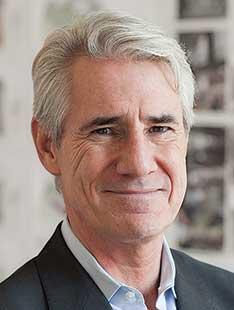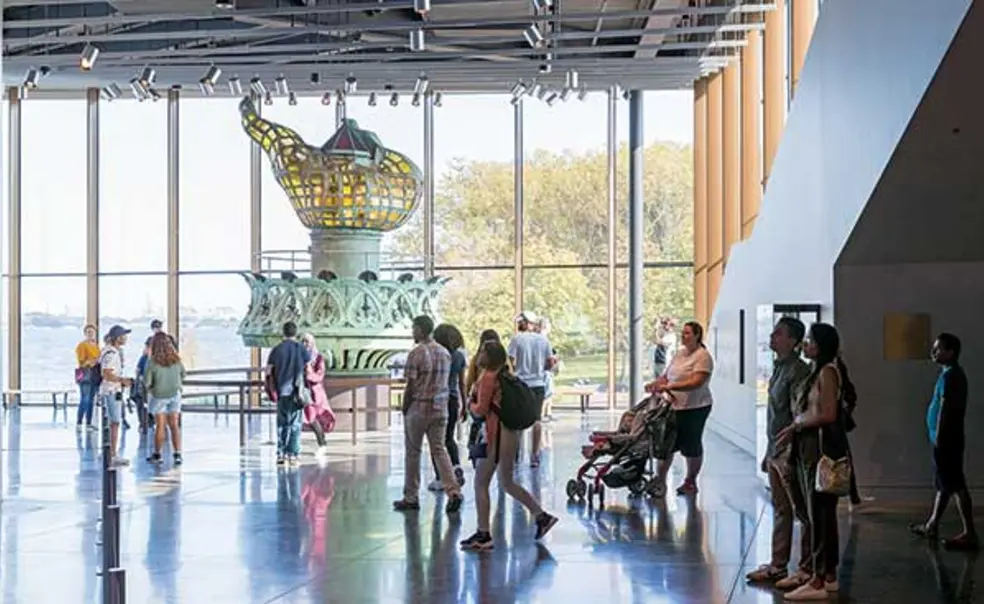Nicholas Garrison ’80 *83: ‘This Is A Sacred Place’
A museum for the recognition of American liberty serves as an architect’s capstone achievement
When Nicholas Garrison ’80 *83 won the commission to design a new museum next to the Statue of Liberty — the largest addition to Liberty Island since the statue arrived in 1886 — he felt a tremendous sense of responsibility.
“This is a sacred place,” he says. “People still come to this island and get on their knees and kiss the ground.”
He designed the building, which opened in May, as a partner and design director at FXCollaborative Architects. Its copper-clad exterior blends with the landscape and will oxidize until its color resembles the statue’s. The museum’s centerpiece is the Statue of Liberty’s original torch, which was replaced in the mid-1980s. The torch is surrounded by 22-foot-high floor-to-ceiling windows that offer a view of the statue looking out onto New York Harbor and beyond.
After viewers take in the museum’s exhibits — a film and displays about the statue’s construction and significance — they arrive at the sight of the torch: “bathed in daylight, set against the statue, and people literally gasp,” Garrison says. The project, which included a second building for security, and landscape improvements, took seven years to design and build and cost $100 million, which was raised from private donors. A review in The Wall Street Journal called the building “a golden door to an iconic monument.”
The 26,000-square-foot museum was carefully designed so that it would not obstruct the spectacular view over New York Harbor, and to take in the sight of the place where the World Trade Center once stood, which can be seen from the building’s windows and its roof, where visitors are invited to walk. “The view links notions of freedom and what it costs with what we’ve sacrificed,” Garrison says. The roof has native plants and grasses, and is a habitat for migrating birds, dragonflies, and butterflies.

For Garrison, the museum is a capstone to a career spent designing buildings for educational and cultural institutions. He frequently uses natural materials and creates structures that work in harmony with the landscape.
At the American International School of Dubai, visitors approach not by entering a lobby, but through an olive grove with fountains and a formal courtyard canopied by date palms. Garrison created outdoor learning spaces in the shade of flowering trees and fragrant vines, inspired by traditional Arabian gardens. At Goucher College, he designed its Athenaeum facility, which houses the library, an art gallery, fitness areas, and more. It employs stone, copper, wood, and glass to define courtyards, paths, and outdoor spaces. The facility won the New Landmark Libraries Award, recognizing innovation in library design, in 2012.
His love of nature was kindled by his father, who planted dozens of nut and apple trees in the family’s Seattle backyard during Garrison’s childhood. On birthdays, a tree would bloom with lollipops, which had been taped to the branches by his father. “He had incredible creative energy, and that drew me to a creative career,” Garrison says.
Garrison, who lives in Princeton, spent 15 years working at the Hillier Group, founded by Robert Hillier ’59 *61. While there, he led the design for the new Princeton Public Library, completed in 2004. His first building project was creating sets for Triangle Club performances at Princeton.
One of his favorite college classes was on Renaissance and post-Renaissance gardens and landscape architecture, taught by David Coffin. What he learned still informs all his designs, including for the Cornell University Laboratory of Ornithology at the Johnson Center for Birds and Biodiversity. The building’s rustic natural materials, unusual shape, and low roof edges blend with the surroundings. Designed as an extension of the 220-acre Sapsucker Woods Sanctuary, the lab sits along a nature trail next to a pond and serves as a “bird-blind,” a shelter from which one can watch birds without scaring them away.












1 Response
Norman Ravitch *62
5 Years AgoWhat exactly will be celebrated?
What exactly will be celebrated? Normally this question would not be even asked. But as historians, propagandists, politicians, and conspiratorialists have worked us all into a frenzy about patriotic beliefs, monuments, and symbols, the question becomes quite à propos.
As someone who has even doubted the oldest form of patriotic gore, I offer my services. I believe the American Revolution was unnecessary, the result of religious and political fanatics in the colonies trying to return to the Puritan Revolution which toppled Charles I and his head, installed Cromwell as a god-given military dictator, and finally with the help of the French created what Franklin called “a republic if you can keep it,” which within two generations became instead a Democracy in which virtue was replaced by vice and honor by money. Since the reign of Andrew Jackson this country has betrayed most of the more elevated prose of our founders.
So what to celebrate on Bedloe’s Island, now apparently called Liberty Island? Without the Revolution we could have been like Canada. How bad would that have been?